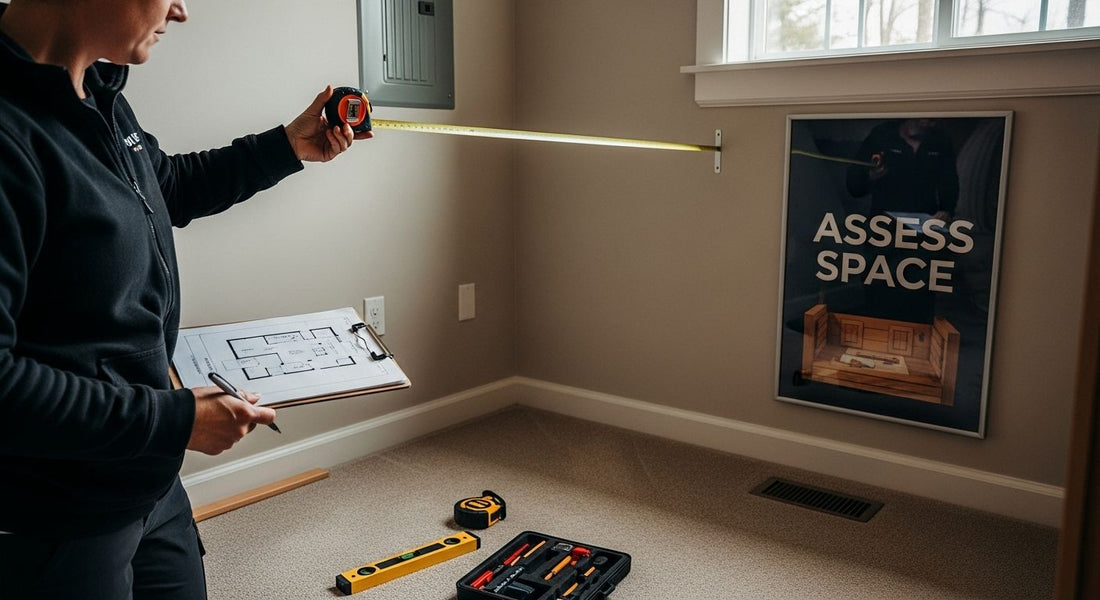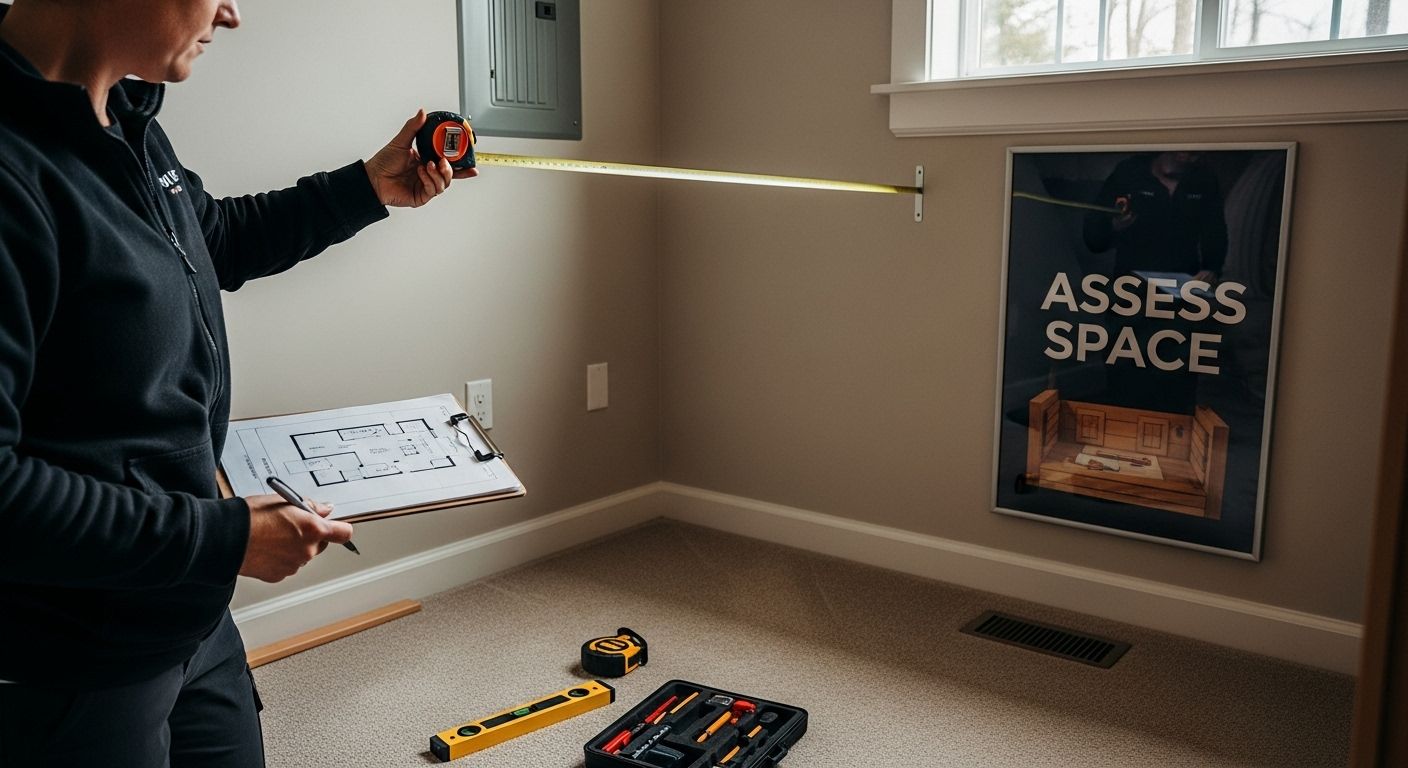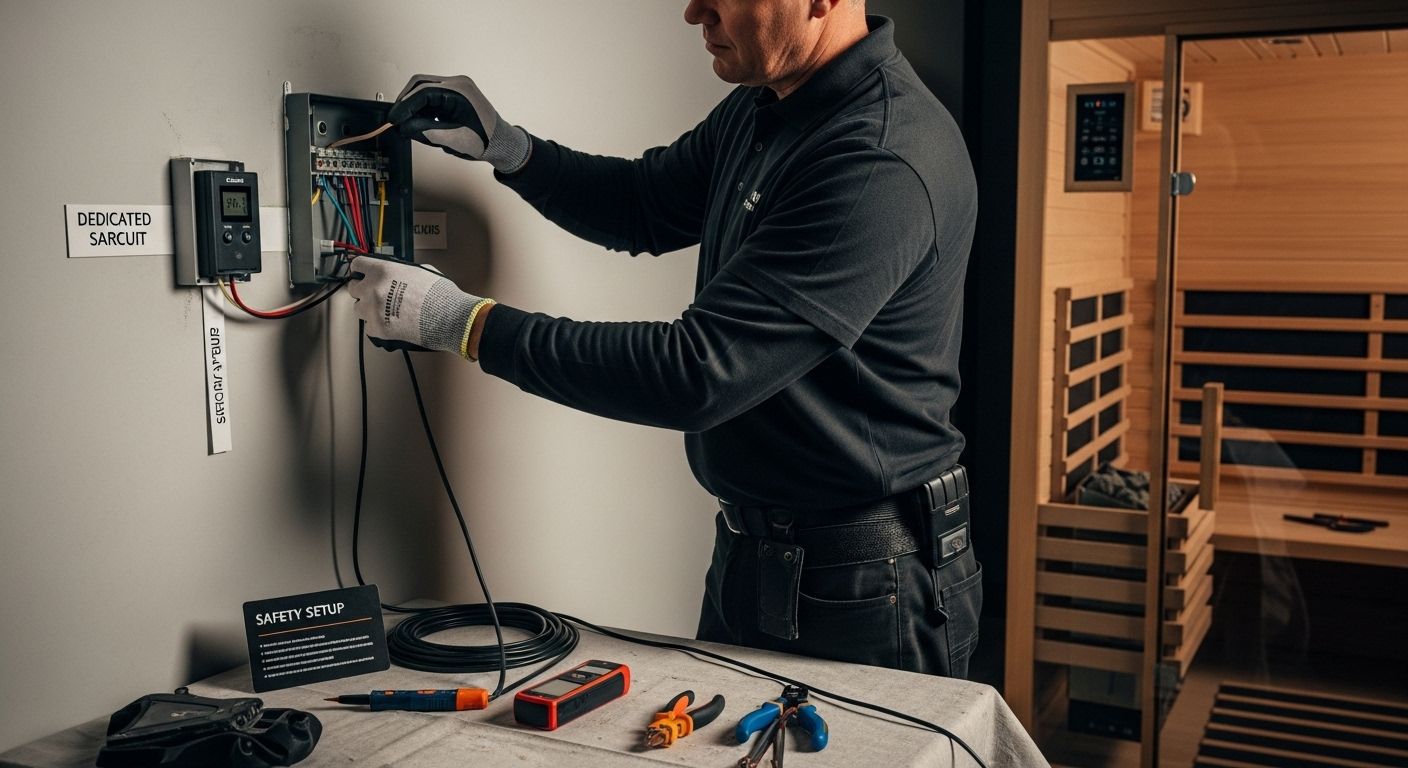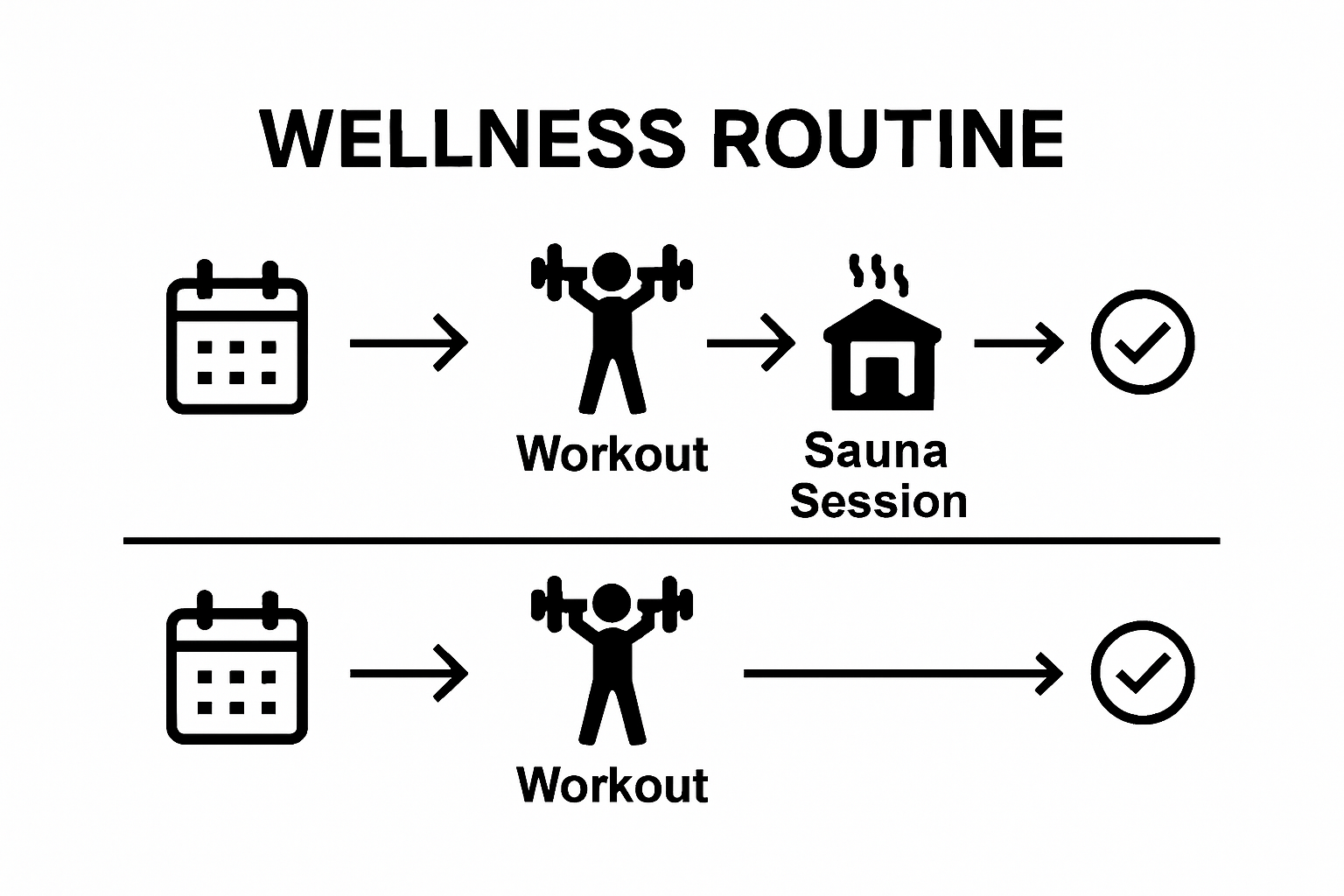
Incorporating Sauna in Routine for Ultimate Relaxation

Building a home sauna can look simple. All you need is some space and the right kit, right? Not so fast. Nearly 60 percent of homeowners underestimate the hidden demands like electrical needs, ventilation, and structural support when installing a sauna. The real surprises come from details that make or break your comfort and safety. Miss these, and your relaxing retreat could turn into a costly headache.
Table of Contents
- Step 1: Assess Your Space for Sauna Installation
- Step 2: Select the Right Type of Sauna for Your Needs
- Step 3: Set Up Your Sauna Following Safety Guidelines
- Step 4: Create a Sauna Schedule for Consistent Use
- Step 5: Incorporate Pre- and Post-Sauna Rituals for Maximum Benefits
Quick Summary
| Key Point | Explanation |
|---|---|
| 1. Assess Your Space Thoroughly | Ensure you evaluate dimensions, electrical, ventilation, and structural factors before installing a sauna. |
| 2. Choose the Right Sauna Type | Select between traditional and infrared saunas based on your health goals and available space. |
| 3. Follow Safety Guidelines for Setup | Ensure proper electrical connections, adequate ventilation, and moisture-resistant materials to enhance safety. |
| 4. Create a Consistent Sauna Schedule | Plan regular sessions, ideally 2-3 times per week, to maximize health benefits from sauna use. |
| 5. Incorporate Pre- and Post-Sauna Rituals | Engage in hydration, cooling, and mindful recovery to enhance and extend the wellness benefits of sauna baths. |
Step 1: Assess Your Space for Sauna Installation
Successful incorporation of a sauna into your wellness routine begins with a critical first step: thoroughly assessing your available space. This foundational evaluation determines not just where your sauna will fit, but how effectively it will integrate into your home environment. The goal is to create a functional, comfortable sauna setup that enhances your relaxation experience.
Starting your sauna installation journey requires careful spatial planning. Begin by identifying potential locations within your home that can accommodate a sauna. These areas might include a spare room, basement, garage, or even a dedicated outdoor space. Consider factors like moisture resistance, electrical accessibility, and proximity to bathrooms or changing areas.
Measuring your designated space is crucial. Pull out a tape measure and record precise dimensions, paying close attention to ceiling height, floor space, and potential obstructions. According to the U.S. Access Board’s guidelines, ensure you have adequate turning space for comfortable movement, with a recommended minimum diameter of 60 inches for accessibility.
Electrical requirements demand careful consideration. Most home saunas require a dedicated 220240 volt circuit, which means consulting an electrician to verify your current electrical setup. Check your home’s electrical panel to confirm you have the necessary amperage and circuit availability. Some homes might need an electrical upgrade to support a sauna installation safely.
Ventilation plays a pivotal role in your sauna’s functionality and longevity. Your chosen space must allow for proper air circulation and potential moisture management. Avoid areas with excessive humidity or limited airflow, as these conditions can compromise your sauna’s structural integrity and performance. Ideal locations typically include spaces with good air exchange, minimal direct sunlight, and stable temperature conditions.
Finally, verify structural considerations. Wooden floors might require reinforcement, while concrete or tile surfaces often provide excellent sauna foundations. Take time to inspect the subfloor, ensuring it can support the sauna’s weight and withstand potential moisture exposure. If you’re uncertain about structural requirements, consulting a professional contractor can provide peace of mind and prevent potential installation complications.
Successful space assessment means you’ve carefully evaluated:
- Precise room measurements
- Electrical circuit compatibility
- Ventilation and moisture conditions
- Structural support capabilities
Step 2: Select the Right Type of Sauna for Your Needs
Choosing the right sauna transforms your wellness routine from a generic experience to a personalized health journey. Your selection will directly impact the effectiveness of your relaxation and recovery strategy. Understanding the nuanced differences between sauna types allows you to make an informed decision that aligns perfectly with your lifestyle, health goals, and spatial constraints.
Traditional saunas represent the classic Finnish experience, characterized by high temperatures and wood-fired or electric heating elements. These saunas generate intense dry heat, typically ranging between 170 to 200 degrees Fahrenheit, creating an authentic sweating experience that promotes deep detoxification. According to research published in the Mayo Clinic Proceedings, traditional saunas have demonstrated significant cardiovascular benefits, making them an excellent choice for individuals seeking comprehensive health improvements.
Infrared saunas offer a modern alternative, operating at lower temperatures while delivering targeted therapeutic heat directly into body tissues. Unlike traditional saunas, infrared models heat your body directly rather than warming the surrounding air. This technology enables deeper penetration of healing warmth, potentially supporting muscle recovery, improved circulation, and enhanced metabolic processes. Infrared saunas prove particularly beneficial for individuals with lower heat tolerance or those seeking more gentle, prolonged therapeutic sessions.
Consider your personal health objectives when selecting a sauna type. Athletes might prefer traditional saunas for intense heat exposure and comprehensive sweating, while individuals managing chronic pain or seeking gentle detoxification could find infrared models more accommodating. Evaluate your physical comfort, available space, and wellness goals to determine the most suitable option.
Budget and installation requirements play significant roles in your selection. Traditional saunas typically demand more extensive electrical work and construction, whereas portable infrared models offer more flexibility. Examine your home’s electrical capacity, available square footage, and long-term maintenance expectations before making a final decision.
Your sauna selection checklist should include:
- Alignment with personal health goals
- Compatibility with home infrastructure
- Budget considerations
- Personal heat tolerance
- Desired therapeutic outcomes
Take time to research different models, read user reviews, and potentially test various sauna types at local wellness centers.
Here is a comparison table to help you understand the key differences between traditional and infrared saunas, so you can better choose the option that fits your health goals and home setup.
| Sauna Type | Heat Source | Temperature Range (°F) | Key Benefits | Ideal For |
|---|---|---|---|---|
| Traditional Sauna | Wood-fired or Electric | 170 - 200 | Intense sweating, deep detox | Comprehensive detox, athletes |
| Infrared Sauna | Infrared Heating Elements | 110 - 150 | Targeted heat, gentle therapy | Muscle recovery, pain relief |
| This investigative approach ensures you select a sauna that genuinely enhances your relaxation and health routine. |
Step 3: Set Up Your Sauna Following Safety Guidelines
Safety transforms your sauna experience from a potential health risk to a therapeutic wellness practice. Setting up your sauna requires meticulous attention to detail, ensuring a secure environment that protects both your physical well-being and the longevity of your investment. Proper installation goes far beyond simple placement it involves creating a comprehensive safety ecosystem.
Electrical considerations demand your primary focus. Professional installation is strongly recommended, particularly for hardwired saunas requiring complex electrical connections. Confirm that your dedicated circuit matches the manufacturer’s specifications, typically 220240 volt configurations. Ensure all electrical connections are professionally sealed, waterproofed, and meet local building codes. An incorrectly wired sauna poses significant fire and shock hazards.
Ventilation represents another critical safety component. Adequate air circulation prevents moisture buildup, potential mold growth, and ensures a comfortable internal environment. Position ventilation openings to facilitate consistent airflow without creating direct drafts that could compromise your heating efficiency. According to research from the Mayo Clinic Proceedings, maintaining appropriate temperature and humidity levels is crucial for safe sauna usage.
Flooring and surrounding surfaces require strategic preparation. Select moisture-resistant materials that can withstand high temperatures and potential water exposure. Wood surfaces should be sealed with heat-resistant treatments, while tile or concrete floors offer excellent foundational support. Create a small drainage area or place waterproof mats to manage potential moisture accumulation. This proactive approach protects both your sauna and surrounding living space.
Temperature control mechanisms demand careful calibration. Install a reliable, easy-to-read thermometer that allows precise monitoring of internal heat levels. Most saunas operate safely between 150 to 195 degrees Fahrenheit, but individual models may have specific recommended ranges. Programmable digital controls offer the most consistent and reliable temperature management.
Emergency preparedness completes your safety setup. Position a fire extinguisher nearby, ensure clear exit paths, and keep a communication device accessible. Establish basic sauna usage guidelines for household members, including maximum session durations and hydration recommendations.

Your sauna safety checklist should include:
- Professionally verified electrical connections
- Proper ventilation configuration
- Heat-resistant flooring
- Calibrated temperature controls
- Accessible emergency equipment
Remember, a well-prepared sauna is not just about comfort it is about creating a secure wellness environment that supports your health journey with minimal risk.
Use this checklist table to review the essential safety steps and preparations recommended for installing your home sauna, ensuring both comfort and peace of mind during use.
| Safety Item | Why It Matters | Preparation Step |
|---|---|---|
| Electrical Connections | Prevents fire/shock hazards | Professional inspection and correct circuit setup |
| Ventilation Configuration | Avoids mold, ensures heat efficiency | Install vents for consistent air flow |
| Heat-Resistant Flooring | Withstands moisture and heat | Use sealed wood, tile, or concrete surfaces |
| Calibrated Temperature Controls | Maintains safe operating range | Install accurate controls and thermometer |
| Emergency Equipment Accessibility | Enables quick response in case of accidents | Place fire extinguisher, clear exit, phone nearby |
Step 4: Create a Sauna Schedule for Consistent Use
Establishing a consistent sauna routine transforms occasional relaxation into a powerful wellness strategy. Your sauna schedule is more than just a calendar entry it is a commitment to your holistic health and personal well-being. The key to maximizing sauna benefits lies not in sporadic use, but in creating a sustainable, integrated approach that harmonizes with your lifestyle and fitness goals.
Begin by conducting an honest assessment of your current weekly schedule. Identify time windows that offer consistent availability and minimal disruption. Many individuals find success by incorporating sauna sessions during natural transition periods like early mornings before work, immediately after workout routines, or during evening wind-down periods. Aim for 23 sessions per week, which aligns with optimal health recommendations.
According to research published in the Mayo Clinic Proceedings, frequency plays a crucial role in realizing comprehensive health benefits. Your initial sessions should start conservatively, typically lasting 1015 minutes and gradually increasing as your body adapts to the heat exposure. Listen to your body and remain flexible, understanding that consistency matters more than marathon sessions.
Integrate your sauna routine strategically with other wellness activities. For individuals engaged in fitness training, scheduling sauna time immediately after strength or cardio workouts can enhance muscle recovery and promote deeper relaxation. Those managing stress might prefer evening sessions that help reset the nervous system and prepare the body for restorative sleep.

Technology can be an excellent ally in maintaining your sauna schedule. Utilize smartphone calendar apps to set recurring reminders, blocking out dedicated sauna time just as you would any other important appointment. Consider tracking your sessions using fitness or wellness apps that allow you to log duration, perceived benefits, and personal observations.
Prepare for potential scheduling challenges by developing backup strategies. Have alternative time slots identified in case your primary session becomes unavailable. Some individuals maintain flexibility by keeping sauna clothing and towels readily accessible, enabling impromptu sessions when unexpected free time emerges.
Your sauna scheduling priorities should include:
- Consistent weekly frequency
- Alignment with personal energy rhythms
- Flexibility for life’s unexpected changes
- Integration with broader wellness goals
- Gradual progression in session duration
Remember, building a sauna routine is a personal journey. What works perfectly for one individual might require modification for another. Stay patient, attentive to your body’s signals, and committed to making sauna sessions a sustainable part of your wellness lifestyle.
Step 5: Incorporate Pre- and Post-Sauna Rituals for Maximum Benefits
Transforming your sauna experience from a simple heat session to a holistic wellness ritual requires intentional preparation and recovery strategies. Pre- and post-sauna rituals are not optional luxuries they are essential components that amplify your physiological and psychological benefits. These carefully designed practices create a comprehensive wellness experience that extends far beyond the sauna’s heated environment.
Pre-sauna preparation begins with strategic hydration. Drink approximately 16 to 20 ounces of water in the hour preceding your session, ensuring your body is well-prepared for intense heat exposure. Light stretching or gentle mobility exercises can help prime your muscles and cardiovascular system, creating a smoother transition into the sauna environment. Avoid heavy meals within two hours of your sauna session, as digestion can interfere with your body’s thermoregulation processes.
According to research published in the Mayo Clinic Proceedings, the physiological benefits of sauna bathing are closely linked to how effectively you prepare and recover. Your pre-sauna ritual should include mental preparation techniques like deep breathing or brief meditation, which help reset your nervous system and enhance your body’s adaptability to heat stress.
Post-sauna recovery demands equally meticulous attention. Immediate cooling represents a critical phase in your wellness routine. Begin by gradually lowering your body temperature through a systematic approach. A lukewarm shower followed by progressive cooling helps your cardiovascular system readjust. Hydration becomes paramount during this phase, replenishing fluids lost through perspiration and supporting your body’s metabolic processes.
Nutritional replenishment plays a significant role in post-sauna recovery. Consume electrolyte-rich foods or beverages that help restore mineral balance. Consider light, nutrient-dense options like coconut water, herbal tea, or fresh fruits that support rapid cellular recovery. Some individuals find success with gentle protein supplements that aid muscle recovery and metabolic restoration.
Mindfulness practices can extend the therapeutic benefits of your sauna session. Spend 510 minutes in a quiet, reflective state immediately after your sauna, allowing your body to integrate the physiological changes. This intentional cooling and reflection period helps modulate your autonomic nervous system, promoting deeper relaxation and stress reduction.
Your comprehensive sauna ritual checklist should include:
- Pre-hydration strategies
- Gentle physical preparation
- Systematic cooling techniques
- Nutritional replenishment
- Mindful recovery period
Remember, these rituals are not rigid prescriptions but adaptable frameworks. Pay attention to your body’s unique responses and modify your approach accordingly, transforming your sauna experience into a personalized wellness journey.
Make Sauna a Core Part of Your Wellness Routine with Best Life Sauna
You have learned how to carefully assess your space, select the right sauna, and follow safety steps for a rewarding and relaxed lifestyle. The article made it clear that finding the best sauna fit, enhancing your experience with proper rituals, and staying consistent are key challenges. Many struggle with how to choose between traditional and infrared saunas, how to create lasting wellness habits, or how to set up at home safely and conveniently.
It should not be hard to transform your home and routine for more healing, comfort, and health. At Best Life Sauna, you can explore a full range of premium infrared, traditional, and outdoor saunas tailored for every space and wellness goal. Alongside saunas, discover thoughtful accessories and wellness bundles that help you work in essential pre- and post-sauna rituals just as the article recommends. Our home page showcases customer reviews and benefits, plus you get free shipping on qualifying orders so you can begin your routine immediately.

Ready to put your relaxation plan into action? Visit Best Life Sauna right now to browse solutions designed for first-time buyers or experienced users alike. Build the foundation of your ultimate relaxation routine today and enjoy expert guidance at every step—from choosing your sauna to helping you create a consistent, nourishing schedule. Don’t wait to unlock the health and comfort you deserve.
Frequently Asked Questions
What are the benefits of incorporating a sauna into my wellness routine?
Incorporating a sauna into your wellness routine offers numerous benefits, including improved relaxation, enhanced muscle recovery, detoxification, and cardiovascular health. Regular sauna use can help reduce stress and promote overall well-being.
How often should I use a sauna for optimal results?
For optimal results, aim for 2-3 sauna sessions per week. Start with shorter sessions (10-15 minutes) and gradually increase the duration as your body adapts to the heat. Consistency is key to gaining the most benefits.
What type of sauna should I choose for my needs?
Choosing the right sauna depends on your personal health goals and preferences. Traditional saunas provide high temperatures and dry heat, ideal for intense detoxification and relaxation. Infrared saunas operate at lower temperatures and offer targeted healing, making them suitable for those with lower heat tolerance or specific pain management needs.
How can I prepare for and recover from a sauna session?
Before using the sauna, hydrate adequately and perform light stretching. After your session, cool down gradually with a lukewarm shower, rehydrate, and consider consuming electrolyte-rich foods to replenish your body. Incorporate mindfulness practices to further enhance relaxation and recovery.

